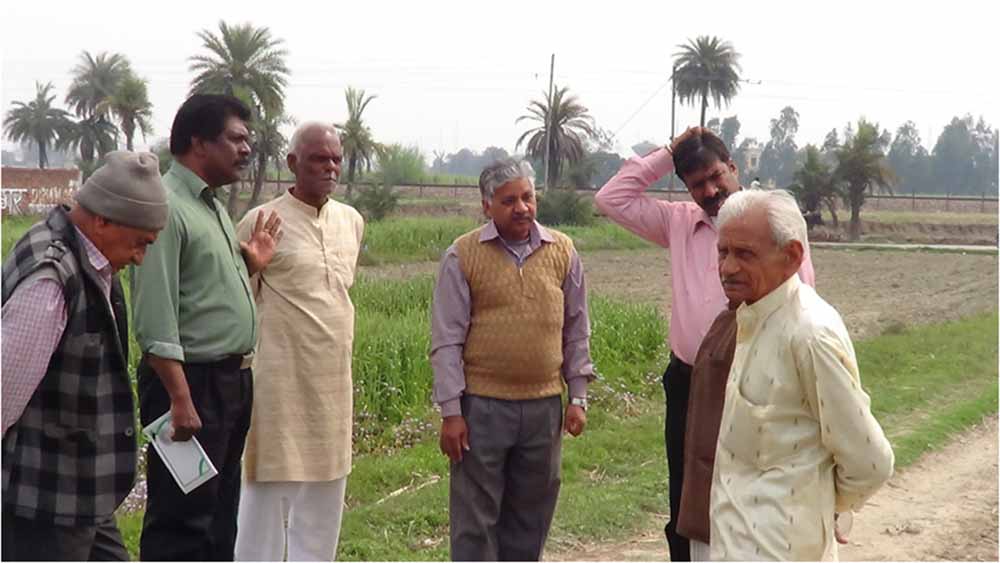Step Back to Step Forward – Toward Resilience and Hardier Crops in India
Apr 4, 2018 I By: Amanda Evengaard and Carolyn Mutter
Highlights of a recently published article on AgMIP India work: Indian agriculture in the face of climate change
In India, people and especially farmers, depend on the monsoon. The timing and amount of the rain is of high importance. Shifts in either can severely impact agriculture unless they are accompanied by shifts in plant varieties, planting practices, or management, collectively called ‘adaptations’. Yet it is often not clear what adaptations to prioritize, or how to bundle them. Farmers and policy-makers alike want to know the likelihood of adaptations helping to avoid falling net returns, declining per capita income, or other factors.
‘’The uncertain future of Indian agriculture’’ (view the article here), was recently published in Fountainink magazine. The article, authored by GBSNP Varma, highlights research from the AgMIP Research Teams working in the Indo-Gangetic Basin (IGB) and South India. Climate change impacts on agriculture is important to understand because India’s dependence on successful agricultural production is high. As noted in the article, more than 56% of people in Tamil Nadu depend on agriculture (and related sectors).

Geetalakshmi at an interaction in Coimbatore. Photo: Special arrangement.
Additionally, for 65% of the state’s population, rural agriculture is the most important source of livelihood. Vellingri Geethalakshmi, AgMIP South India Principal Investigator shares how farmers ‘’agonize over hotter summers, unseasonal rain, and extreme fluctuations in the amount of precipitation’’.

Subash (second from left) with farmers in Modinagar during the north India study. Photo: Special arrangement.
The article summarizes findings from model-based assessments of climate variability and change for agricultural systems. The science teams consider how past, current and likely future climate could affect staple crops, livestock, and households in an agricultural community. The method provides estimates of the percentage of the population that will benefit from uptake of adaptations tested for current and future scenarios called ‘agricultural pathways’ that are established with stakeholders and planners in the study regions. This helps make sure exploration and prioritization of decisions about adaptations include contexts of current as well as future direction in policy and planning. An area to further develop involves “more farming/cropping systems in India to get a real estimate of the impacts of climate change,” notes Subash.
AgMIP methods, they have helped to co-developed them. An important component of the involves stepping back and engaging stakeholders about the role of models in helping with decisions.
Together, researchers and stakeholders establish the plausible scenarios or pathways envisioned for the future. Quantifying these in models enables the forward-looking analyses of how adaptations applied now may (or may not) address longer term and cumulative effects of changing climate.
In consideration of the findings, author GBSNP Varma observes that the transition away from heritage crops to those consisting mostly of wheat and rice may be exacerbating the impact felt from the increased temperatures and changing rainfall patterns for the relatively recently introduced staple crops, and considers whether climate forces may encourage a return to a more diverse food basket than wheat and rice even if official policies do not. Previously, the Indian diet mostly consisted of millet, sorghum and pulses with only small portions of rice and wheat. Sonali McDermid, Climate scientist and assistant professor at New York University, concurs that there may be a need to: “Revert toward the older tradition, combining plants that are both climate-tolerant and nutritionally dense. That’s good in a way. I think that’s inevitable, something that we should welcome.”
The regional studies undertaken in India have counterparts that have been advanced in West, East, and Southern Africa and Pakistan, with results from each available for viewing in a beta ‘Impacts Explorer’ (insert link), a web based information and knowledge exploration tool. In addition, the work of the researchers links to a new AgMIP initiative to link results across scales through Coordinated Global and Regional Assessments.
These and other topics will be presented and discussed at the forthcoming Seventh Global Workshop of AgMIP (AgMIP7; April 24-26, 2018, San José, Costa Rica) at the headquarters of the Inter-American Institute for Cooperation on Agriculture (IICA). IICA and AgMIP have co-organized AgMIP7 as a mix of plenary, parallel presentation, and work sessions to share recent results of scientists in the AgMIP community, and to engage interested scientists in collaborative planning of priority research. Scientists in many countries of Latin America and the Caribbean have expressed interest to join AgMIP and advance integrated assessments in their regions, with the aim to render better information on which to establish national development plans and commitments. Find more information on the sessions and presenters of the AgMIP7 global workshop here.
View the article here.

Sonali McDermid has studied the Indian monsoon processes for many years. Photo: Special arrangement.
